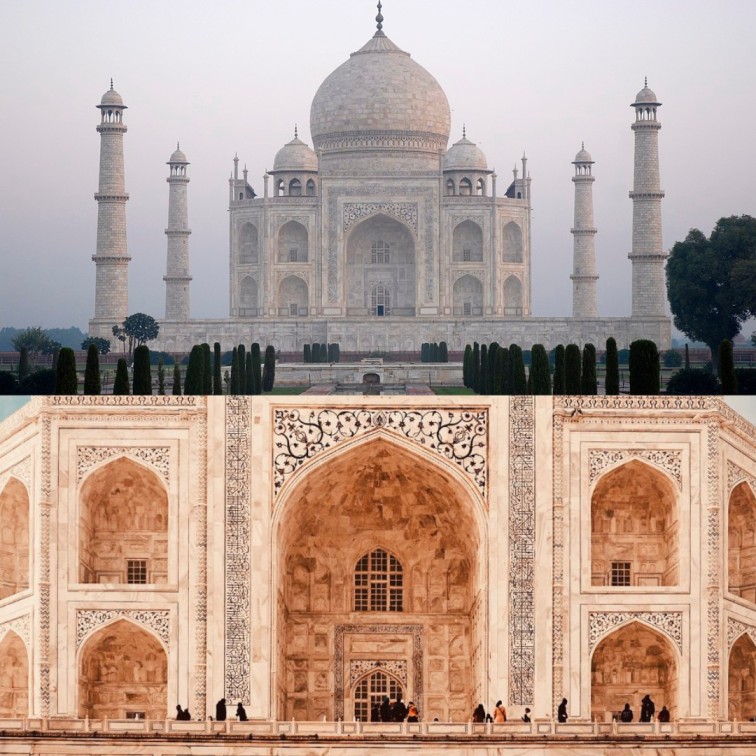Here’s a detailed overview of the Taj Mahal—everything you need to know about this iconic monument:
The Taj Mahal, one of the most celebrated monuments in the world, stands as a timeless symbol of love, devotion, and exquisite craftsmanship. This architectural masterpiece, located on the banks of the Yamuna River in Agra, India, was built by Mughal Emperor Shah Jahan in memory of his beloved wife, Mumtaz Mahal. It is widely regarded as one of the finest examples of Mughal architecture, blending Persian, Islamic, and Indian influences seamlessly.
The Love Story Behind the Taj Mahal
The story of the Taj Mahal begins in the early 17th century when Prince Khurram, later known as Shah Jahan, fell deeply in love with Arjumand Banu Begum, a Persian noblewoman of extraordinary beauty and intelligence. She became his second wife in 1612, receiving the title Mumtaz Mahal, meaning “Jewel of the Palace.” She was not only his queen but also his trusted advisor, accompanying him on military campaigns and political matters.
In 1631, while giving birth to their 14th child, Mumtaz Mahal tragically passed away. Her death left Shah Jahan heartbroken, and in her memory, he vowed to create a monument that would reflect his undying love for her. Thus, the idea of the Taj Mahal was born
Construction and Architecture
The construction of the Taj Mahal began in 1632 and took approximately 22 years to complete. While the main structure was finished by 1648, additional work on the surrounding structures and gardens continued until 1653. The project employed over 20,000 artisans, including architects, stonecutters, inlayers, calligraphers, painters, and laborers from across the Mughal Empire and beyond.
The chief architect is believed to be Ustad Ahmad Lahauri, a Persian architect who led a team of skilled artisans. Materials were sourced from across India and neighboring regions:
White marble from Makrana, Rajasthan
Jasper from Punjab
Turquoise from Tibet
Lapis lazuli from Afghanistan
Sapphire from Sri Lanka
Carnelian from Arabia
These precious stones were intricately inlaid into the marble using a technique called pietra dura, creating mesmerizing floral patterns.
Design and Layout
The Taj Mahal complex is a vast and meticulously planned structure that consists of several key elements:
The Mausoleum:
The main tomb, which houses the cenotaphs of Mumtaz Mahal and Shah Jahan, stands on a raised platform.
It features a grand onion-shaped dome, 73 meters (240 feet) high, surrounded by four slender minarets, each tilted slightly outward to prevent collapse onto the main structure in case of an earthquake.
The Gardens:
The surrounding Charbagh gardens, inspired by Persian paradise gardens, are divided into four sections by water channels, symbolizing the four rivers of paradise in Islamic tradition.
These gardens were originally filled with exotic plants and fountains that enhanced the tranquil beauty of the monument.
The Mosque and Guest House:
To the left of the Taj Mahal is a red sandstone mosque, used for prayers.
To the right is an identical building called the Jawab (meaning “answer”), built for symmetry but not used as a mosque.
The Gateway:
A magnificent entrance gate made of red sandstone welcomes visitors, inscribed with verses from the Quran, emphasizing the theme of paradise and eternity
Later History and Decline
Shah Jahan’s reign took a tragic turn when his son, Aurangzeb, seized the throne in 1658 and placed him under house arrest at Agra Fort. From his prison cell, Shah Jahan could only gaze at the Taj Mahal in longing. He spent the last eight years of his life in captivity, mourning the loss of Mumtaz Mahal and the decline of his empire.
In 1666, Shah Jahan passed away, and Aurangzeb ensured that his body was placed beside Mumtaz Mahal in the Taj Mahal, marking the only element of asymmetry in the otherwise perfectly balanced monument.
Colonial Era and Restoration Efforts
During the British colonial period in the 19th century, the Taj Mahal suffered neglect and plundering. British officers removed precious stones and silver doors from the monument. However, recognizing its historical significance, Lord Curzon, the British Viceroy of India, ordered extensive restoration efforts in the early 1900s, ensuring the Taj Mahal retained its former glory.
Modern Significance
A Global Icon of Love and Heritage
The Taj Mahal remains one of the most visited and admired monuments in the world. In 1983, it was designated a UNESCO World Heritage Site for its cultural and architectural significance. Additionally, in 2007, it was recognized as one of the New Seven Wonders of the World, further solidifying its status as a global icon.
Each year, millions of tourists from across the globe visit the Taj Mahal to witness its breathtaking beauty, especially during sunrise and sunset when the white marble reflects hues of pink, orange, and gold. The monument also plays a significant role in India’s tourism and economy, drawing visitors eager to experience its magnificence firsthand.

Conclusion
The Taj Mahal is more than just an architectural wonder—it is a monument to eternal love, a masterpiece of artistic brilliance, and a symbol of India’s rich cultural heritage. It continues to inspire poets, lovers, historians, and travelers from around the world, standing as a testament to the grandeur of the Mughal Empire and the enduring power of love.
Visitor Statistics
In the financial year 2023-2024, the Taj Mahal welcomed approximately 6.09 million domestic tourists, marking a 20.7% increase from the previous year. This significant rise in footfall highlights the enduring appeal of the monument, despite challenges posed by the COVID-19 pandemic in previous years.
Before the pandemic, the Taj Mahal typically attracted 7 to 8 million visitors annually, including over 800,000 foreign tourists. However, due to travel restrictions and lockdowns, these numbers saw a drastic decline. Fortunately, the site has been witnessing a steady recovery. By 2023, international visitors had risen to 396,900, and by 2024, this number further increased to 681,000.
Peak Visiting Seasons
The Taj Mahal experiences the highest influx of visitors during the cooler months of October, November, and February. These months offer a more comfortable climate, making it ideal for sightseeing. Summers in Agra can be extremely hot, which discourages many tourists from visiting during peak daytime hours.
Additionally, national holidays and festival seasons, such as Diwali and New Year, also see a surge in visitors. The weekends are particularly crowded, as both domestic and international tourists flock to witness the grandeur of this UNESCO World Heritage Site.
Impact of COVID-19 on Tourism
The global pandemic had a severe impact on tourism worldwide, and the Taj Mahal was no exception. During the lockdown periods, the site remained closed for extended durations, leading to a significant decline in footfall. In the financial year 2022-2023, domestic visitor numbers were around 4.5 million, which was lower than pre-pandemic levels. However, the numbers have since rebounded, showcasing the monument’s resilience and continued appeal.
Entry and Access Restrictions
To ensure the preservation of the monument and control crowding, several regulations have been put in place:
Weekly Closure: The Taj Mahal is closed to tourists every Friday as it is reserved for religious prayers.
Traffic Restrictions: To minimize pollution damage, no polluting vehicles are allowed near the monument. Visitors must walk from designated parking areas or use electric buses and battery-operated vehicles provided by the authorities.
Entry Tickets: Visitors need to purchase tickets online or at designated counters, with separate pricing for domestic, SAARC, and international tourists.








